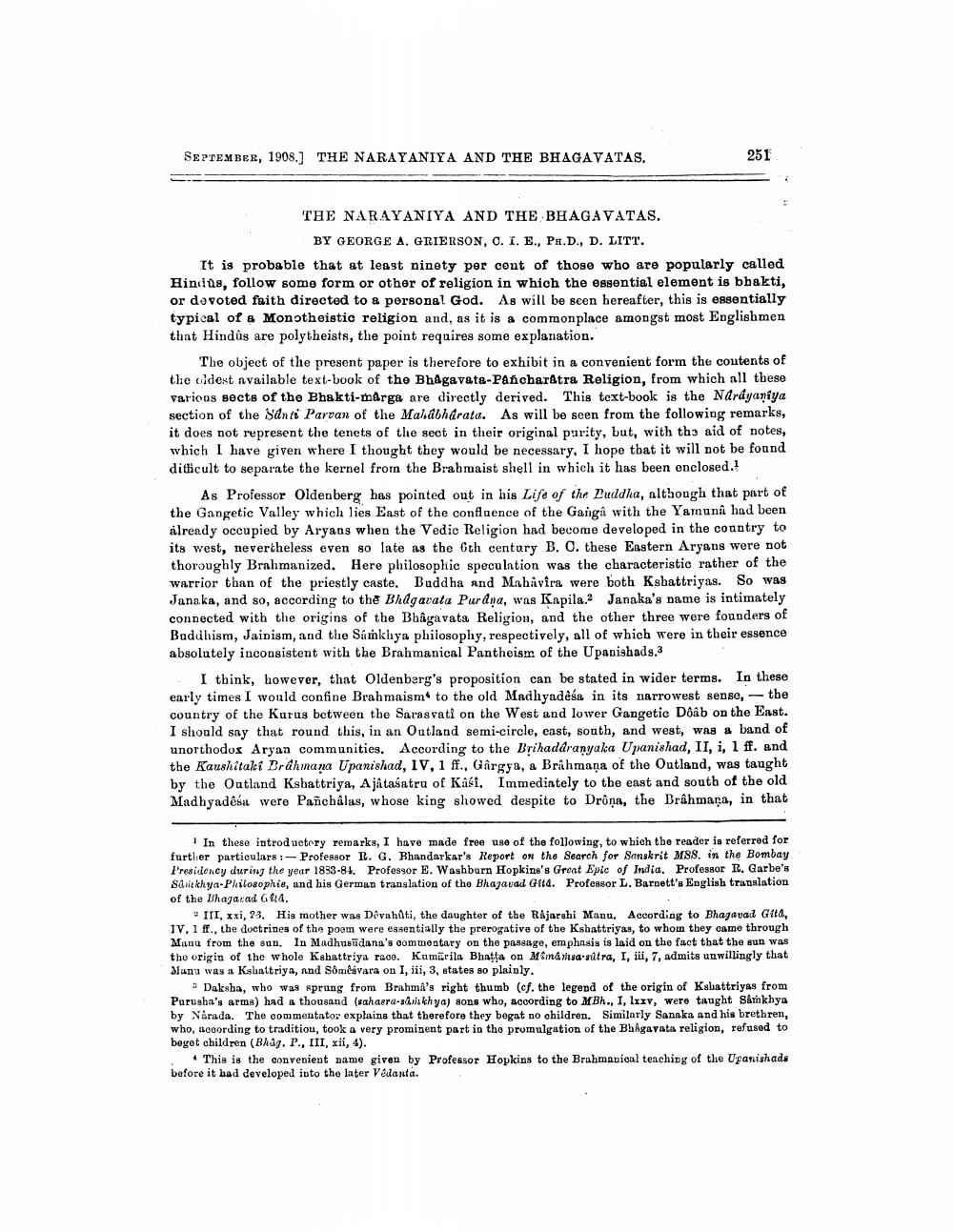________________
SEPTEMBER, 1908.) THE NARAYANIYA AND THE BHAGAVATAS.
25
THE NARAYANIYA AND THE BHAGAVATAS.
BY GEORGE A, GRIERSON, C. I. E., PH.D., D. LITT. It is probable that at least ninety per cent of those who are popularly called Hindus, follow some form or other of religion in which the essential element is bbakti, or devoted faith directed to a personal God. As will be seen hereafter, this is essentially typical of & Monotheistic religion and, as it is a commonplace amongst most Englishmen that Hindûs are polytheists, the point requires some explanation.
The object of the present paper is therefore to exhibit in a convenient form the contents of the oldest available text-book of the Bhagavata-Pancbarátra Religion, from which all these various sects of the Bhakti-marga are directly derived. This text-book is the Narayaniya section of the Sdnti Parvan of the Mahabharata. As will be seen from the following remarks, it does not represent the tenets of the sect in their original parity, but, with th3 aid of notes, which I have given where I thought they would be necessary, I hope that it will not be found ditficult to separate the kernel from the Brabmaist shell in which it has been enclosed.!
As Professor Oldenberg has pointed out in his Life of the Buddha, although that part of the Gangetie Valley which lies East of the confluence of the Ganga with the Yamunâ had been already occupied by Aryans when the Vedic Religion had become developed in the country to its west, nevertheless even so late as the 6th century B. O. these Eastern Aryans were not thoroughly Brahmanized. Here philosophic speculation was the characteristic rather of the warrior than of the priestly caste. Buddha and Mahavira were both Ksbattriyas. So was Janaka, and so, according to the Bhagavata Purdņa, was Kapila.2 Janaka's name is intimately connected with the origins of the Bhagavata Religion, and the other three were founders of Buddhism, Jainism, and the Sanklya philosophy, respectively, all of which were in their essence absolutely inconsistent with the Brahmanical Pantheism of the Upanishads.3
I think, however, that Oldenberg's proposition can be stated in wider terms. In these early times I would confine Brahmaism to the old Madhyadéša in its narrowest sense, the country of the Kurus between the Sarasvati on the West and lower Gangetic Dôåb on the East. I should say that round this, in an Outland semi-circle, east, south, and west, was a band of unorthodos Aryan communities. According to the Brihadaranyaka Upanishad, II, i, 1 ff. and the Kaushitaki Brahmana Upanishad, IV, 1 ff., Gargya, a Brahmana of the Outland, was taught by the Oatland Kshattriya, A játasatru of Kasi. Immediately to the east and south of the old Madhyadéśat were Panchâlas, whose king showed despite to Drôņa, the Brahmara, in that
1 In these introductory remarks, I have made free use of the following, to which the reader is referred for further particulars :- Professor R. G. Bhandarkar's Report on the Search for Sanskrit M88. in the Bombay Presidency during the year 1833-81. Professor E. Washburn Hopkins's Great Epic of India. Professor R. Garbe's Sankhya-Philosophie, and his German translation of the Bhagavad Gita. Professor L. Barnett's English translation of the Bhagavad G6:4.
III. xxi, 23. His mother was Dévahati, the daughter of the Rajarshi Manu. According to Bhagavad Gita, IV, 1 ff., the doctrines of the poem were essentially the prerogative of the Kshattriyas, to whom they came through Man from the sun. In Madhulidana's commentary on the passage, emphasis is laid on the fact that the sun was the origin of the wholo Kshattriya race. Kumärila Bhatta on Mmd rusa sútra, I, iii, 7, admits unwillingly that dlana was a Kshatriya, and Somèsvara on I, iii, 3, states so plainly.
Daksha, who was sprang from Brahmi's right thumb (cf. the legend of the origin of Ksliattriyas from Purusha's arms) had a thousand (sahasra-sdriskhya) sons who, according to MBh., I, lxxv, were taught Sárinkhya by Nárada. The commentator explains that therefore they begat no children. Similarly Sanaka and his brethren, who, according to traditiou, took a very prominent part in the promulgation of the Bhhgavata religion, refused to boyet children (Bldg. P., III, xii, 4).
• This is the convenient name given by Professor Hopkins to the Brahmanical teaching of the Upanishads before it had developed into the later Vådanta.




